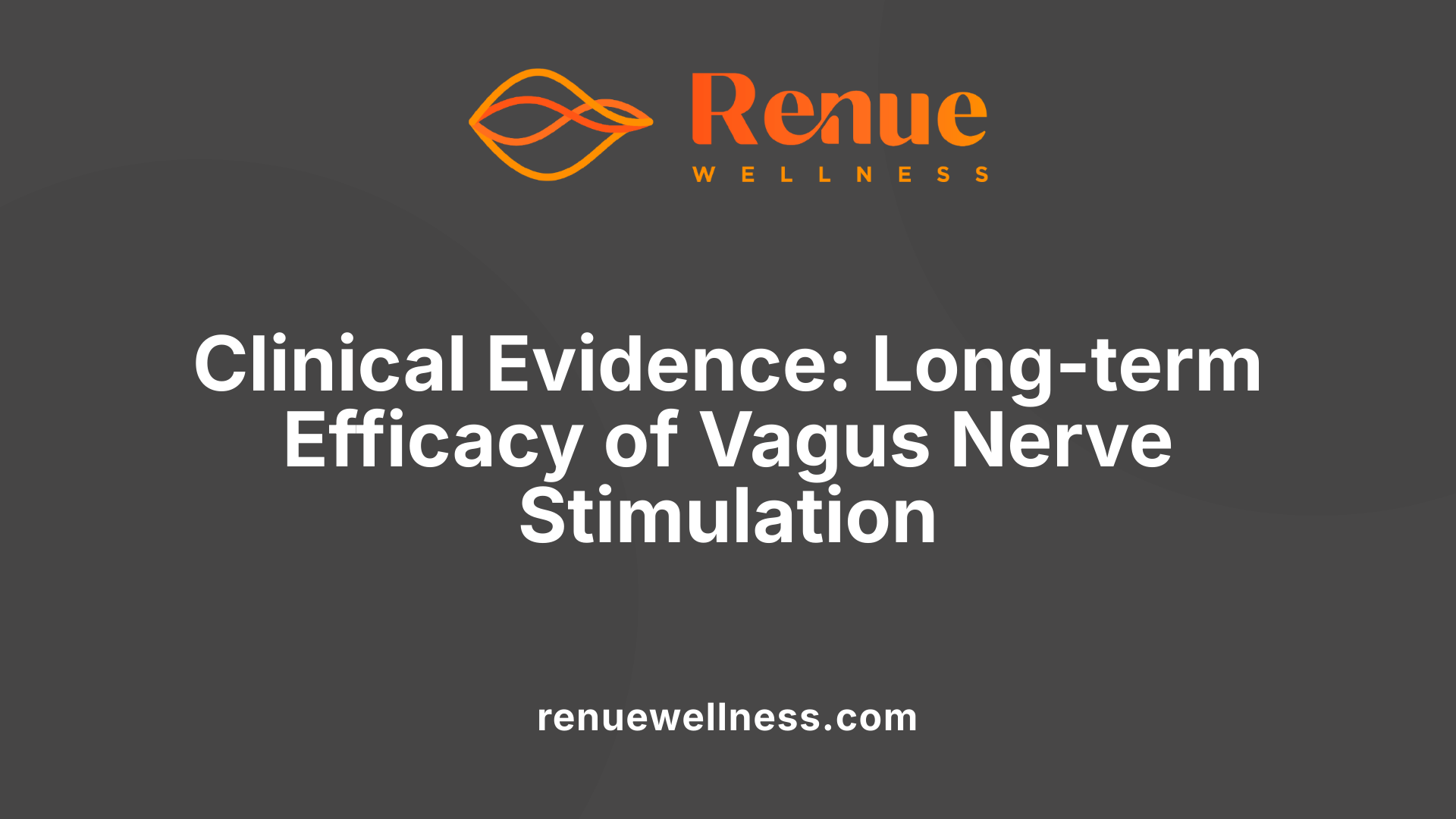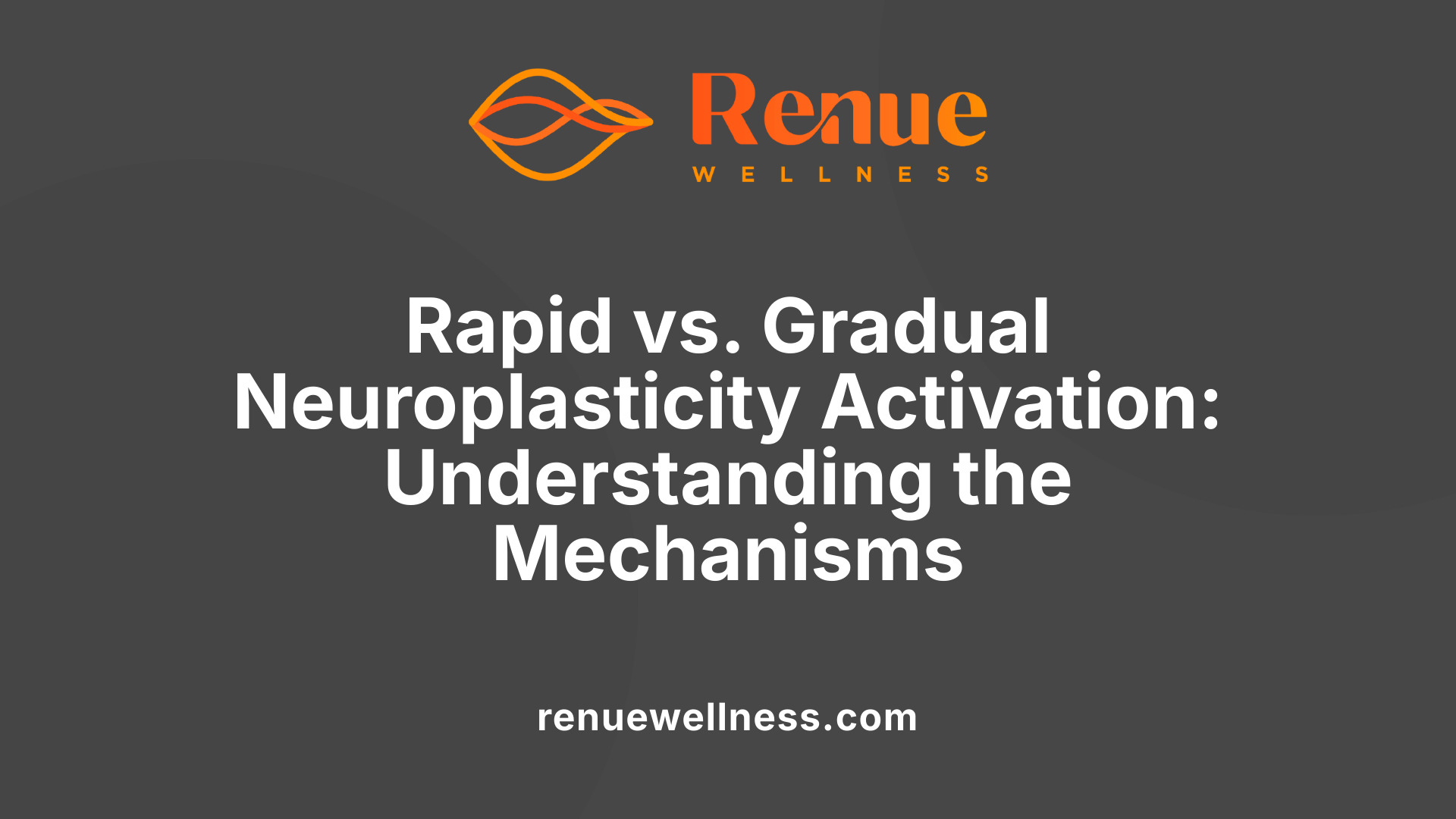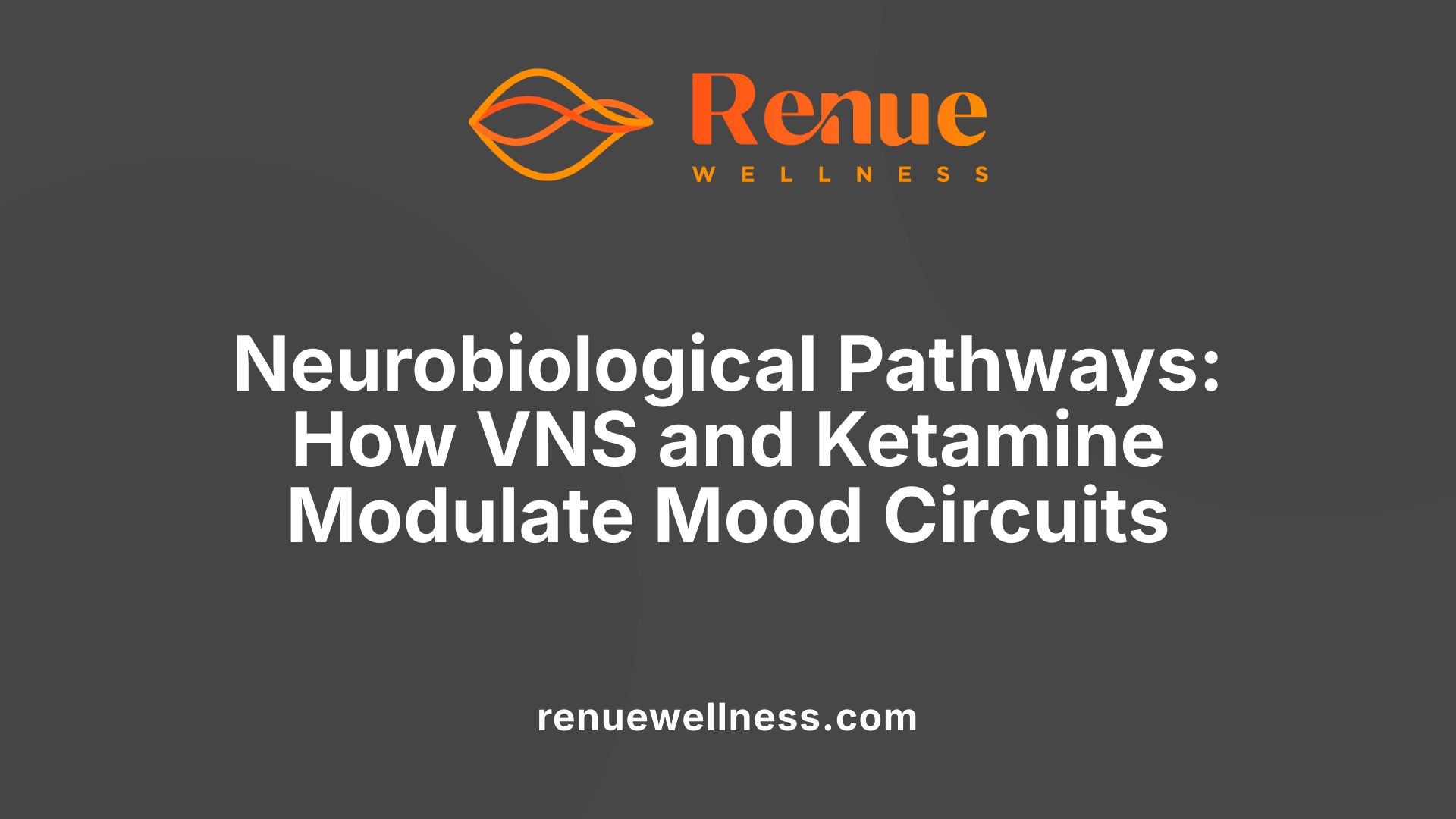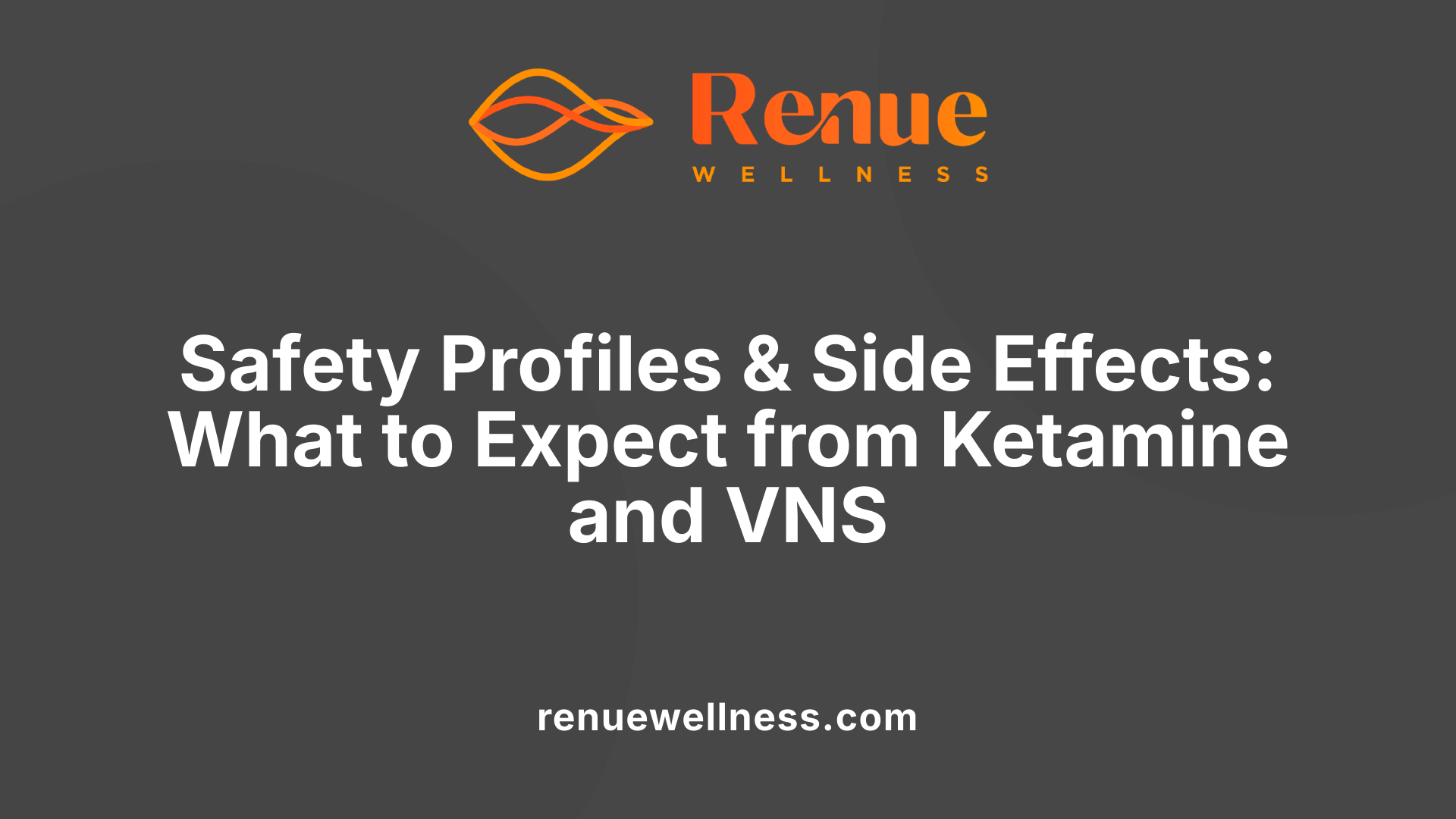Clinical Outcome Comparisons: Ketamine vs. Vagus Nerve Stimulation


July 31, 2025
Understanding Treatment-Resistant Depression Strategies
Major depressive disorder (MDD), especially in its treatment-resistant form, demands a variety of innovative approaches. Among the advanced therapies, ketamine and vagus nerve stimulation (VNS) stand out due to their distinct mechanisms, efficacy profiles, and long-term outcomes. This article delves into a comprehensive comparison of these two modalities, exploring their clinical effectiveness, mechanisms of action, safety profiles, research evidence, and decision-making considerations to better inform treatment options for patients with complex depression.
Overview of Treatment-Resistant Depression and Novel Interventions
What is treatment-resistant depression?
Treatment-resistant depression (TRD) refers to a form of depression that does not respond adequately to multiple standard treatments, including several different antidepressant medications, psychotherapy, or other established interventions. Patients with TRD often experience prolonged episodes, high symptom severity, and an increased risk of suicidal ideation and physical health complications. Traditional treatments may fall short, prompting the need for alternative strategies.
Introduction to ketamine and vagus nerve stimulation
In recent years, innovative therapies like ketamine and vagus nerve stimulation (VNS) have gained attention for their effectiveness in managing TRD. These approaches target different biological mechanisms associated with depression.
Ketamine, originally developed as an anesthetic, has shown rapid antidepressant effects within hours, especially beneficial for urgent cases involving suicidal ideation. It modulates glutamate neurotransmission, enhances neuroplasticity, and activates neurotrophin pathways involving brain-derived neurotrophic factor (BDNF), resulting in quick symptom relief. However, the antidepressant effects of ketamine tend to be transient, typically lasting about two weeks without ongoing treatment.
VNS, on the other hand, involves surgically implanting a device that sends electrical impulses to the vagus nerve. This stimulation influences brain regions involved in mood regulation, including the limbic system, prefrontal cortex, and areas rich in serotonergic and noradrenergic neurons. Over time, VNS produces gradual but sustained improvements in depressive symptoms, with response rates increasing over months of continuous therapy.
Both treatments aim to modify neural circuits and promote neuroplasticity, but they differ notably in their onset, durability, and safety profiles.
How do patient outcomes and safety profiles compare between ketamine and vagus nerve stimulation?
Ketamine and VNS are both promising in alleviating severe depression, but each has distinct advantages and considerations.
Efficacy and Onset of Action
- Ketamine offers rapid relief, often within hours to days, making it valuable in urgent situations involving high suicide risk. Its effects can decrease suicidal ideation quickly.
- VNS produces gradual responses, typically observed after 3 to 12 months of treatment. Long-term studies show increasing response and remission rates over time, with some patients experiencing significant improvements after a year or more.
Long-Term Outcomes
- Ketamine effects are often short-lived without repeated dosing, necessitating maintenance protocols. While effective for immediate symptom control, its long-term benefits are still under investigation.
- VNS demonstrates durable benefits, with long-term studies reporting sustained response rates—about two-thirds of patients maintaining improvements over several years—and lower relapse rates.
Safety Profiles
- Ketamine can cause side effects such as dissociation, increased blood pressure, dizziness, and potential for dependence. Generally, these effects are transient but require careful monitoring, especially with repeated administration.
- VNS is well-tolerated in most cases, with most adverse effects being mild and temporary. Common issues include voice alteration, coughing, and throat discomfort, which tend to decrease over time.
Summary Comparison
| Aspect | Ketamine | Vagus Nerve Stimulation |
|---|---|---|
| Onset | Hours to days | Several months |
| Duration of effect | Up to 2 weeks without maintenance | Several years, with sustained response |
| Safety concerns | Dissociation, hypertension, dependence potential | Mild, transient side effects like voice changes |
| Suitability | Acute relief, rapid symptom reduction | Long-term management, relapse prevention |
In conclusion, ketamine is particularly useful for immediate symptom relief, especially in cases with high suicidality, but needs ongoing treatment for lasting benefits. VNS provides a more gradual but durable improvement in depression with a favorable safety profile, making it an attractive option for long-term management of TRD.
Future directions in depression treatment
The ongoing research aims to optimize these treatments, identify precise biological targets, and combine therapies for better outcomes. Understanding neuroplasticity pathways, neurotrophin signaling like BDNF and TrkB, and brain circuit modulation will continue to shape innovative interventions for those suffering from resistant depression.
Clinical Evidence Supporting VNS in Treatment-Resistant Depression

What are the long-term response and remission rates of VNS?
Vagus nerve stimulation (VNS) has shown promising long-term outcomes for patients with treatment-resistant depression (TRD). Studies indicate that after five years of therapy, approximately 67.6% of patients respond to treatment, with response defined as at least a 50% reduction in depressive symptoms. Moreover, remission rates—measured by the elimination of significant depressive episodes—reach about 43.3% after five years.
The response and remission rates tend to improve over time, emphasizing the importance of sustained treatment. Most patients who initially respond continue to experience benefits, with durability observed in two-thirds of responders over the long term. A large European multi-center registry involving 599 patients demonstrated that VNS-based adjunct therapy significantly enhances overall quality of life, even when depression symptoms do not respond fully to traditional treatments.
How does VNS compare with usual treatment outcomes?
Compared to treatment-as-usual (TAU), VNS significantly outperforms in several measures. In the same large registry, the cumulative 5-year response rate for VNS plus TAU was nearly double that of TAU alone—approximately 67.6% versus 40.9%. Similarly, remission rates with VNS were markedly higher—43.3% versus 25.7%. These findings suggest that introducing VNS as a third-line treatment after failure of multiple antidepressant trials provides substantial benefits.
Functional improvements are also notable. Patients receiving VNS experience enhancements in various aspects of daily life, including mood, household activities, leisure, and social relationships. Notably, these benefits can occur even at lower levels of symptom reduction than what traditional response criteria typically denote.
What is the impact of VNS on suicidal ideation and overall mortality?
VNS therapy contributes to a significant reduction in suicidal ideation, a critical aspect of severe depression. Long-term studies reveal that VNS effectively lowers the risk of suicide-related behaviors. Quantitative data demonstrate that compared to usual treatment, VNS can halve the rates of all-cause mortality and suicide. This makes VNS not only valuable for symptom management but also crucial in reducing mortality risk associated with chronic depression.
The anti-suicidal effect is thought to stem from VNS's ability to modulate brain regions involved in mood and emotional regulation, such as the dorsal raphe nucleus and prefrontal cortex, thereby fostering neuroplasticity and stabilizing neural circuits prone to depressive dysregulation.
Long-term safety and efficacy profiles of ketamine and VNS for TRD
Both ketamine and VNS exhibit considerable promise for long-term management of TRD with favorable safety profiles when appropriately monitored.
VNS has been used for decades, with extensive research affirming its safety and efficacy over periods extending beyond two years. It is associated with minimal safety concerns, and side effects—such as voice alterations and coughing—are generally transient. Neuroplastic mechanisms, including modulation of neurotransmitter systems and activation of neurotrophin pathways like brain-derived neurotrophic factor (BDNF) and TrkB, underpin its sustained benefits.
Ketamine, particularly via intranasal esketamine, demonstrates rapid antidepressant effects within hours, which can be maintained with repeated administration. Long-term use has been reported as well tolerated, with most adverse effects being mild or transient. Nonetheless, concerns about dependence and potential cognitive effects do exist, but current evidence suggests these issues are limited when treatment protocols are followed strictly.
Combining VNS with ketamine could potentially extend and stabilize treatment benefits, possibly reducing the need for frequent doses or additional therapies. Still, more research is needed to fully appreciate the safety profile of such combined approaches.
In conclusion, both VNS and ketamine offer durable treatment options for TRD, with evolving data supporting their safety and long-term efficacy. While VNS provides sustained neuroplasticity-driven benefits with minimal safety risks over years, ketamine offers rapid symptom relief with manageable side effects. Continued scientific exploration will help optimize their use and establish best practices for long-term management of depression.
Mechanisms of Action: Rapid vs. Gradual Neuroplasticity Activation

How do the mechanisms of action differ between ketamine and vagus nerve stimulation in treating depression?
Ketamine and vagus nerve stimulation (VNS) are both recognized for their capacity to promote neuroplasticity, but they operate through different pathways and temporal patterns.
Ketamine acts rapidly as an NMDA receptor antagonist. This blockade results in a sudden surge of glutamate release, which subsequently stimulates AMPA receptors. The activation of these receptors triggers downstream signaling cascades, notably the mTOR pathway, leading to quick synaptogenesis and strengthening of neural connections. Simultaneously, ketamine boosts neurotrophin activity, especially increasing levels of brain-derived neurotrophic factor (BDNF) and activating its receptor TrkB. These effects collectively support rapid enhancement of neuronal resilience and synaptic plasticity, often within hours and typically lasting around two weeks.
In contrast, VNS influences depression-related neural circuits via different mechanisms. The electrical stimulation targets the vagus nerve, primarily the left side to minimize cardiac side effects. This stimulation modulates activity in brain regions involved in mood regulation, such as the dorsal raphe nucleus and locus coeruleus, resulting in increased release of serotonin and norepinephrine over an extended period. Additionally, VNS activates neurotrophin pathways like BDNF-TrkB signaling, but these changes tend to develop gradually. Long-term VNS therapy can take months to produce significant neuroplastic effects, with sustained improvements in mood and cognition.
While ketamine exerts its effects through rapid modulation of glutamatergic and neurotrophic pathways, fostering quick synaptic remodeling, VNS restores neurochemical balance through slower, progressive modulation of neurotransmitter systems and neuroplasticity mechanisms.
| Aspect | Ketamine | VNS |
|---|---|---|
| Mode of Action | NMDA receptor antagonism leading to glutamate surge | Electrical stimulation of vagus nerve affecting neural circuits |
| Temporal Pattern | Rapid, within hours, effects lasting weeks | Gradual, over months, with cumulative benefits |
| Neuroplasticity Pathways | Activates mTOR, increases BDNF quickly | Activates BDNF-TrkB pathway over time |
| Neurotransmitter Effects | Immediate increase in glutamate, serotonin, norepinephrine | Sustained elevation of serotonin, norepinephrine, dopamine |
| Key Features | Fast-acting, transient neuroplasticity | Long-term modulatory effects |
Understanding these differences helps tailor treatments to depression’s urgency and individual patient profiles. Ketamine’s rapid action is valuable for acute symptom relief, especially suicidal ideation, whereas VNS contributes to enduring neural adaptations and sustained remission.
Neurobiological Pathways Involved in Depression and Treatment Response

How does VNS activate brain regions involved in mood regulation?
Vagus nerve stimulation (VNS) exerts its therapeutic effects by activating several crucial brain areas associated with mood and emotion regulation. Neuroimaging studies have demonstrated bilateral changes in the limbic system, hippocampus, amygdala, dorsal raphe nucleus, locus coeruleus, and prefrontal cortex. Specifically, VNS stimulates afferent pathways that project to the nucleus accumbens, dorsal raphe, and prefrontal cortex, orchestrating a network involved in mood control.
These regions collectively modulate neurochemical signals and neural plasticity, which can help alleviate depressive symptoms. The activation of the dorsal raphe nucleus increases serotonin release, while stimulation of the locus coeruleus elevates noradrenaline levels, contributing to enhanced mood stability. This multi-regional activation supports long-term plastic changes, ultimately improving emotional regulation.
Which neurotransmitter systems are modulated by VNS and ketamine?
Both VNS and ketamine influence neurotransmitter systems that are central to depression management, though they do so through different mechanisms.
| Neurotransmitter System | Modulation by VNS | Modulation by Ketamine | Effect on Depression |
|---|---|---|---|
| Serotonin (5-HT) | Increased firing of serotonergic neurons in the dorsal raphe nucleus | Indirectly increased via neuroplasticity pathways | Enhances mood and resilience |
| Norepinephrine (NE) | Elevated activity in locus coeruleus neurons | Indirect effects via neurotrophic factor signaling | Improves alertness and mood |
| Dopamine (DA) | Modulation through limbic and prefrontal pathways | Less direct, but some influence via circuit connections | Enhances motivation and reward |
| GABA and Glutamate | Modulated through complex feedback loops | Ketamine blocks NMDA receptors affecting glutamatergic transmission | Balances excitatory and inhibitory signals to promote plasticity |
Ketamine primarily acts on the glutamatergic system by blocking NMDA receptors, leading to a surge in glutamate transmission. This rapid action induces synaptogenesis and boosts neurotrophic factors like BDNF, fostering neuroplasticity. VNS, however, modulates these neurotransmitter systems more gradually through neural pathways that influence brain regions involved in mood regulation.
What is the role of neurotrophin signaling in neuroplasticity?
Neurotrophins, particularly brain-derived neurotrophic factor (BDNF), are vital for neuroplasticity—the brain's ability to adapt by forming new neural connections. Both VNS and ketamine activate pathways that increase BDNF activity and TrkB receptor phosphorylation, which is essential for neuronal survival, growth, and synaptic remodeling.
In depression, serum BDNF levels are generally decreased, correlating with reduced neuroplasticity. Treatments like VNS and ketamine help restore these levels, promoting synaptic growth and resilience against depressive pathology. VNS activates TrkB phosphorylation at multiple sites, similar to classical antidepressants, leading to long-lasting structural changes in the brain.
Neurotrophin signaling enhances the formation of new dendrites and synapses, especially in the hippocampus, which is heavily involved in mood regulation. This process facilitates better emotional regulation and cognitive function, underpinning the sustained antidepressant effects seen with long-term VNS and ketamine therapy.
Efficacy and Response Rates for VNS and Ketamine
What are the response and remission rates over time?
Vagus nerve stimulation (VNS) has shown promising long-term results in treating treatment-resistant depression (TRD). Clinical studies report response rates—defined as a significant reduction in depressive symptoms—ranging from approximately 27% to 42%. Remission rates, indicating minimal or no depressive symptoms, are observed between 15% and 39%. These rates tend to improve gradually, often becoming more evident after the first year of therapy.
Patients typically experience progressive benefits, with many showing increased response rates over an extended period. For example, a five-year registry study found that around 67.6% of patients responded to VNS therapy after this period, with remission rates reaching roughly 43.3%. Additionally, long-term use enhances quality of life and functional outcomes, with improvements often seen after 12 months or longer.
In contrast, ketamine—a newer pharmacological treatment—demonstrates rapid antidepressant effects. Many patients show symptom reduction within hours of administration, with response rates often surpassing 50%. However, these effects typically last about two weeks without ongoing treatment or maintenance strategies. Unlike VNS, which relies on neural stimulation over months or years, ketamine’s rapid action suits immediate relief but may require repeated dosing to sustain benefits.
How do baseline characteristics influence treatment outcomes?
Baseline severity of depression and patient age appear to impact treatment response for both VNS and ketamine. For VNS, studies show that patients with higher depression severity or older age (above 65 years) experience more substantial reductions in depressive symptoms. For example, in the RESTORE-LIFE study, older patients and those with more severe depression had greater decreases in MADRS scores.
Similarly, ketamine's efficacy can be affected by baseline factors. Patients with more severe or chronic depression may show more pronounced improvements, but individual responses vary. The duration of illness and prior treatment history also influence outcomes, underscoring the importance of personalized approaches.
How do these treatments compare with traditional antidepressants?
Traditional antidepressants, including SSRIs and SNRIs, often have limited success in TRD, with response rates around 20-30%. Many patients do not achieve sufficient symptom relief, leading to the need for alternative therapies like VNS and ketamine.
VNS provides an advantage by offering sustained response and remission over long periods, with some studies reporting up to a 5-year response rate of around 68% and remission of about 43%. Unlike traditional medications, VNS can improve not only mood symptoms but also functional outcomes and quality of life.
Ketamine offers rapid symptom relief within hours to days, a significant contrast to the delayed onset typical of conventional antidepressants, which may take weeks. However, ketamine's effects are often transient without ongoing treatments, posing challenges for maintaining long-term remission.
To summarize, both VNS and ketamine have demonstrated superior efficacy over standard antidepressants in treatment-resistant cases, with VNS being more suitable for sustained long-term management and ketamine being advantageous for quick symptomatic relief.
Comparison Table of VNS and Ketamine in Treating Depression
| Aspect | Vagus Nerve Stimulation (VNS) | Ketamine | Details |
|---|---|---|---|
| Response Rates | 27-53% | >50% | Both show efficacy, with VNS response improving over time; ketamine provides rapid response |
| Remission Rates | 15.8-39% | Variable, generally lower | Sustained remission more common in VNS |
| Onset of Effect | Gradual (months) | Rapid (hours to days) | VNS benefits accrue slowly, ketamine acts quickly |
| Durability | Long-term, maintained over years | Short-lived unless repeated | VNS offers enduring effects; ketamine may require ongoing administration |
| Mechanism | Neuroplasticity modulation via neural stimulation | Neurotransmitter modulation, neurotrophin release | Both involve neuroplasticity pathways, including BDNF and TrkB |
| Side Effects | Minimal, some voice alteration and coughing | Transient, include dissociation, fatigue | Safety profiles differ, with VNS generally well-tolerated |
| Impact on Quality of Life | Significant, long-lasting | Transient improvements | Both treatments enhance life quality, more sustained with VNS |
This comparison highlights the complementary roles of VNS and ketamine. VNS offers a sustained, long-term strategy, especially suitable for continuing management of depression, while ketamine provides rapid relief useful in acute settings or when immediate symptom reduction is required.
Understanding their distinct temporal profiles and mechanisms allows clinicians to tailor treatment plans effectively for individuals suffering from resistant depression, optimizing both immediate and long-term outcomes.
Invasiveness, Treatment Duration, and Patient Considerations

What factors influence the decision to use ketamine versus vagus nerve stimulation for depression?
Choosing between ketamine and vagus nerve stimulation (VNS) for treating depression depends on various clinical and patient-specific factors. Each option offers distinct advantages and considerations, making tailored treatment approaches essential.
One of the primary considerations is the speed of therapeutic effects. Ketamine, an NMDA receptor antagonist, boasts rapid antidepressant actions, often within hours of administration. This makes it particularly suitable for patients facing severe symptoms or suicidal ideation requiring urgent relief. In contrast, VNS typically requires a longer period—often 3 to 12 months—before significant improvement becomes evident, making it more appropriate for long-term management rather than immediate symptom control.
Patient response history to prior treatments also influences therapy choice. Patients who have not benefitted from traditional pharmacotherapies may be directed towards VNS, especially if rapid response is not a priority. Conversely, patients needing swift symptom alleviation may prefer ketamine as the initial intervention.
The invasiveness of each procedure plays a crucial role. VNS involves a surgical implant of a device that delivers electrical stimulation to the vagus nerve, primarily targeting neural circuits involved in mood regulation. This surgery, while generally safe, requires a hospitalization and carries associated surgical risks. Ketamine, on the other hand, is administered intravenously or via intranasal routes, which are less invasive and can be administered in outpatient settings.
Patient preferences, lifestyle, and medical history are also pivotal. For instance, individuals with comorbidities contraindicating surgery might opt for ketamine. Those reluctant to undergo surgical procedures or concerned about device maintenance may prefer pharmacological approaches.
Additional factors include safety profile and side effects. VNS can cause transient voice alterations and coughing, while ketamine has been associated with side effects such as dissociation and potential abuse risk. Long-term safety considerations and potential side effects are weighed carefully.
Ethical and prognostic factors, such as the patient's overall health, prior treatment failures, and treatment goals, further guide decision-making. For example, prolonged, sustained remission might be more achievable with VNS, especially in treatment-resistant cases.
In summary, the decision to opt for ketamine or VNS involves assessing the urgency of symptom relief, invasiveness of procedures, patient preferences, response history, medical contraindications, and safety considerations. Engaging patients in shared decision-making ensures that the chosen therapy aligns with their values and clinical needs.
Side Effects and Safety Profiles of Ketamine and VNS

What are the common side effects of ketamine, including concerns about dependence?
Ketamine, often used as a fast-acting treatment for treatment-resistant depression, presents several side effects that clinicians carefully monitor. Patients may experience psychotomimetic effects such as hallucinations and perceptual disturbances, especially at higher doses or with repeated administration. Additionally, ketamine can cause transient increases in blood pressure and heart rate, which require blood pressure monitoring during treatment.
Another concern is the potential for dependence. While outpatient use of ketamine under medical supervision has shown low rates of addiction when used appropriately, repeated misuse or high doses can lead to psychological dependence, raising concerns for long-term safety.
Overall, these side effects are typically manageable with controlled dosing, careful patient selection, and ongoing medical supervision.
Time Course of Therapeutic Effects and Delayed Responses
How quickly do ketamine’s effects manifest, and what is the typical timeline for VNS to show benefits?
Ketamine is renowned for its rapid antidepressant effects. Administered as an NMDA receptor antagonist, it often begins alleviating depressive symptoms within hours after infusion. Patients typically experience a significant mood improvement rapidly, with some reporting reduced suicidal ideation within the first few hours to days. However, these effects are transient, usually lasting about two weeks, and may require additional dosing or combination therapy for sustained relief.
In contrast, vagus nerve stimulation (VNS) does not bring immediate symptom relief. Instead, VNS’s therapeutic benefits accrue gradually over several months of continuous stimulation. Many patients begin to notice improvements after about 3 to 6 months, with substantial responses often emerging after a year or more of ongoing therapy. Long-term studies indicate that VNS response and remission rates improve over time, with cumulative response rates reaching approximately 40-67% over five years.
What are the implications for treatment planning?
The differing timelines of these treatments influence clinical decisions significantly. For patients requiring urgent relief from severe depression or suicidal ideation, ketamine’s rapid onset makes it a preferable short-term intervention. Its quick action can be life-saving and offers symptomatic relief while longer-term strategies are implemented.
Conversely, for individuals with chronic, treatment-resistant depression who may benefit from sustained neuroplasticity and long-term stability, VNS becomes a compelling option. Its delayed but steady improvements make it suitable for those who can tolerate the invasive procedure and are seeking durable relief.
Combining these therapies can be advantageous: ketamine can be used for rapid symptom reduction, followed by VNS to maintain and enhance long-term outcomes. Regular assessments and personalized treatment plans are essential to optimize timing and efficacy.
Factors influencing the choice between ketamine and VNS
Deciding between ketamine and VNS involves multiple considerations:
- Urgency of symptom relief: Immediate needs favor ketamine.
- Treatment history: Previous response to therapies influences modality choice.
- Invasiveness: VNS requires surgical implantation; ketamine is administered intravenously.
- Patient preference: Some patients prefer less invasive options.
- Side effect profiles: Management and potential adverse effects differ.
- Long-term outlook: VNS offers sustained benefits, making it suitable for long-term management.
Understanding these timelines and factors helps clinicians develop tailored treatment strategies, maximizing benefits and minimizing risks for individuals battling resistant depression.
Impacts on Suicidal Ideation and Social Function
How do ketamine and vagus nerve stimulation reduce suicidal thoughts?
Both ketamine and vagus nerve stimulation (VNS) have demonstrated significant potential in lowering suicidal ideation among patients with treatment-resistant depression (TRD). Ketamine, an NMDA receptor antagonist, acts rapidly, often within hours of administration, leading to a swift reduction in suicidal thoughts. This fast-acting property makes it particularly valuable in emergency scenarios where immediate intervention is necessary. Studies show that ketamine’s acute effects can last for approximately two weeks, providing a crucial window for stabilization.
VNS, on the other hand, achieves its anti-suicidal effects through long-term modulation of brain regions involved in mood regulation and neuroplasticity. Clinical research indicates that VNS can lower the relative risk of suicidal ideation and reduce all-cause mortality by about half compared to usual treatments. Its effects tend to develop gradually, often observable after 12 months or more of continuous treatment. The stimulation activates neural circuits associated with mood and resilience, leading to sustained improvements.
Can VNS and ketamine enhance social cognition and social functioning?
Recent advancements suggest that both VNS and ketamine might positively influence social cognition and functioning in depressed individuals. Conventional treatments often show limited efficacy in improving social skills, which are crucial for overall recovery. However, novel therapies like these seem to modulate neural networks responsible for empathy, emotion regulation, and self-referential processing.
VNS impacts regions such as the prefrontal cortex, amygdala, and hippocampus—areas central to social behavior and emotional processing. Neuroimaging studies reveal that VNS produces bilateral changes in these regions, promoting neuroplasticity and improving social interactions. Similarly, ketamine’s rapid enhancement of glutamatergic transmission fosters neuroplasticity and may lead to better social functioning over time.
Animal models support these findings, showing that neuroplasticity underlies improvements in social behavior. Activation of neurotrophin pathways, especially involving brain-derived neurotrophic factor (BDNF) and its receptor TrkB, appears central to these effects, fostering neuronal survival and network restructuring.
What are the potential neuroplastic changes associated with these treatments?
Neuroplasticity is a key mechanism underlying the therapeutic effects of both VNS and ketamine. VNS promotes neuroplasticity by increasing neurogenesis in the hippocampus, enhancing dendritic arborization, and activating neurotrophic signaling pathways. It elevates BDNF levels and its receptor TrkB activation, contributing to neuronal growth and synaptic strength.
Ketamine similarly enhances neuroplasticity by stimulating glutamatergic transmission, inducing synaptogenesis, and transiently activating the mTOR pathway, leading to increased BDNF release. These processes support long-lasting structural and functional brain changes that alleviate depressive symptoms.
Table 1 summarizes the common neuroplastic effects of VNS and ketamine:
| Treatment | Neuroplastic Mechanism | Associated Outcomes | References |
|---|---|---|---|
| VNS | Increased neurogenesis, dendritic growth | Improved mood, social functioning | Neuroimaging, animal studies |
| Ketamine | Synaptogenesis, mTOR activation | Rapid mood elevation, anti-suicidal effects | Preclinical, clinical research |
Understanding these neuroplastic changes is essential for developing future targeted therapies that maximize benefits while minimizing side effects.
How do these treatments affect long-term outcomes?
Long-term studies reveal that both VNS and ketamine lead to durable improvements, although via different trajectories. VNS, with its gradual modulation, often results in sustained remission and improved quality of life, even when symptom reduction is modest initially. Its safety profile remains favorable with minimal cognitive side effects.
Ketamine’s rapid response can be beneficial in acute episodes, stabilizing patients quickly. However, concerns regarding repeated usage and potential side effects like dissociation or organ toxicity necessitate cautious application. Combining ketamine’s swift effects with VNS’s durable benefits could offer an optimized approach for long-term management.
In conclusion, these therapies significantly impact suicidal ideation and social functioning through distinct approaches to neuroplasticity and circuit modulation. While ketamine offers immediate relief, VNS provides sustained benefits, with ongoing research continually enhancing understanding of their mechanisms and long-term outcomes.
Patient Outcomes and Quality of Life Measures in VNS Studies
What factors influence the decision to use ketamine versus vagus nerve stimulation for depression?
Choosing between ketamine and vagus nerve stimulation (VNS) for treating depression depends on several treatment-related considerations and patient-specific factors.
Ketamine is favored for its rapid action, often producing antidepressant effects within hours, making it suitable for acute situations, especially in patients with severe suicidal ideation. In contrast, VNS is a long-term therapy, with benefits typically emerging after several months of sustained stimulation, and is often considered for patients with chronic, treatment-resistant depression.
Previous response to therapies significantly impacts the choice. Patients who have not responded to multiple pharmacotherapies might be more suitable for VNS, especially when rapid relief is not an immediate priority. Patient preferences also play a role, with some favoring the less invasive nature of medication over surgical procedures, while others may opt for the implant-based approach of VNS.
Medical history, including comorbidities and risk factors for side effects, influences decision-making. VNS requires surgical implantation, which might be contraindicated in patients with certain medical conditions, whereas ketamine, administered typically via nasal spray or infusion, poses different risks.
Treatment goals, such as immediate symptom relief versus sustained remission, guide the selection. For urgent cases, ketamine’s prompt antidepressant effect may be preferable. Conversely, for long-term management, VNS offers the potential for enduring improvement, including reductions in suicidal ideation and associated mortality.
Considering combination therapies is also relevant. Some patients might receive VNS alongside conventional treatments or other neuromodulation techniques. Ethical and procedural considerations, such as the invasiveness of VNS and the controlled, investigational status of ketamine in some regions, also influence clinician choice.
Ultimately, the decision depends on an individualized assessment balancing the urgency of symptoms, treatment history, patient preferences, safety profiles, and healthcare infrastructure.
Clinical outcomes and long-term impacts of VNS in depression management
Clinical studies have demonstrated that VNS provides notably durable improvements in depression symptoms. Response and remission rates tend to increase gradually over time, with many patients experiencing significant symptom reduction after 12 months or longer of therapy.
In a large European multi-centre trial, about 37% of patients responded (⩾50% symptom reduction) at three months, with response rates rising to over 53% after one year. Remission rates (HAMD-28 score <10) similarly increased from 17% at three months to 33% after a year, indicating that VNS’s effectiveness improves with continued use.
Long-term follow-up (up to five years) reveals positive impacts on various aspects of patients’ lives, beyond symptom alleviation. Patients often show meaningful improvements in social functioning, household activities, leisure, and relationships. These effects were assessed through instruments like the Q-LES-Q-SF, which measure quality of life (QoL).
A comprehensive five-year study of patients with TRD found that those receiving VNS plus treatment as usual (TAU) experienced a 34% reduction in depressive symptoms, with significant improvements in physical health, mood, and social domains, compared to TAU alone. Notably, many improvements in QoL occurred even when symptom reduction was below the classical response threshold, highlighting VNS’s broader benefits.
A patient-centered focus shows that improvements in social functioning are critical, as they are directly linked to better overall outcomes and reduced hospitalization rates. Patients report feeling more capable of engaging in daily activities, maintaining social relationships, and participating in meaningful activities, which contributes to sustained remission.
Impact on hospitalization rates, relapse, and overall health
VNS’s long-term benefits include a reduction in relapse and hospitalization rates among patients with severe depression. Studies indicate that VNS therapy can decrease the frequency and severity of depressive episodes, often delaying or preventing relapse.
Initial trials reveal that the majority of patients who respond to VNS maintain their response over several years, with some studies reporting up to 67% of responders sustaining significant improvement over five years. Such durable responses contribute to fewer hospitalizations, reduced emergency interventions, and improved prognosis.
The anti-suicidal effects observed with VNS further underscore its role in improving survival and life quality. Data suggest that VNS can halve the relative risk of suicidal ideation and significantly decrease all-cause mortality compared to treatment-as-usual.
Comparative analysis of VNS and other treatments in patient-centered outcomes
| Treatment Modality | Response Rate | Remission Rate | Quality of Life Improvement | Time to Effect | Notable Side-effects | Suitability for Long-term Use |
|---|---|---|---|---|---|---|
| VNS (Long-term) | 27-42% | 15-39% | Significant improvement, sustained over years | 12+ months | Mild, transient effects (voice alteration, cough) | High, especially in TRD |
| Ketamine (Rapid onset) | Rapid (hours) | Sustained ~2 weeks | Variable, with quick mood improvements | Hours to days | Dissociation, blood pressure spikes | Limited, mainly acute |
These findings reflect that both VNS and ketamine occupy important but distinct roles in depression treatment, tailored to patient needs, symptom severity, and treatment history.
Summary and Future Directions in Depression Treatment
How do ketamine and vagus nerve stimulation compare in terms of clinical evidence and approval?
Both ketamine and vagus nerve stimulation (VNS) have garnered approvals for treating treatment-resistant depression (TRD), but they differ significantly in their mechanisms, onset of effects, and long-term effectiveness.
Ketamine, primarily used as an NMDA receptor antagonist, is recognized for its rapid antidepressant response. Its approval in many countries like the U.S. and European nations is based on extensive clinical trials that demonstrate quick symptom relief often within hours, with effects typically lasting around two weeks. However, concerns about side effects, potential for relapse, and the need for repeated dosing have prompted ongoing research into optimizing its safety and long-term use.
VNS, on the other hand, involves surgically implanting a device that delivers electrical impulses to the vagus nerve. This therapy is also approved in several countries for TRD and epilepsy. Clinical studies over many years reveal that VNS provides a gradual, yet sustained, improvement in depressive symptoms, with response rates ranging from 27% to 53%, and remission rates of 15% to 39%. Notably, responses tend to improve over time, often becoming evident after 12 months or longer.
While ketamine's effects are immediate, they tend to diminish without repeated administration unless combined with other therapies. VNS, with its slower onset, offers durable benefits that can last for years, as long as the device functions effectively. Both treatments impact neuroplasticity pathways: ketamine transiently activates mTOR signaling and increases brain-derived neurotrophic factor (BDNF), leading to synaptogenesis; VNS influences similar pathways, activating TrkB receptors over time and promoting neuroplastic changes.
In summary, ketamine provides a fast-acting option for immediate symptom relief but faces ongoing concerns about long-term management and safety. VNS is suited for sustained, long-term treatment, especially in patients who benefit from gradual symptom improvement. Both strategies are supported by robust clinical evidence, but they serve different therapeutic niches within the management of TRD.
Future Perspectives in Neurostimulation and Pharmacotherapy
As the landscape of depression treatment advances, understanding the distinct and overlapping mechanisms of ketamine and vagus nerve stimulation is crucial. While ketamine offers rapid relief, its transient effects highlight the need for combination approaches or maintenance strategies. VNS provides durability and a favorable safety profile, making it an attractive long-term option, especially for severe and chronic cases. Future research should focus on personalized treatment algorithms, exploring synergistic effects, and further elucidating the neurobiological underpinnings to optimize outcomes for patients with treatment-resistant depression. Integrating pharmacological and neurostimulation therapies promises a comprehensive approach that could redefine standards of care, ultimately improving quality of life for individuals battling this complex disorder.
References
- Focus on Vagal Nerve Stimulation and Ketamine - PubMed Central
- focus on vagal nerve stimulation and ketamine - PubMed
- Setting Up a Successful Vagus Nerve Stimulation Service for ...
- Focus on Vagal Nerve Stimulation and Ketamine - ResearchGate
- From antidepressants and psychotherapy to oxytocin, vagus nerve ...
- Chronic Vagus Nerve Stimulation Significantly Improves Quality of ...
- Preliminary Results from RESTORE-LIFE Shows Promise for VNS in ...
- Vagus Nerve Stimulation (VNS) and Other Augmentation Strategies ...
Recent Posts
Conditions Treated
AnxietyDepressionOCDPTSDPostpartum DepressionPain ManagementSubstance AbuseSuicidal IdeationOur Location


